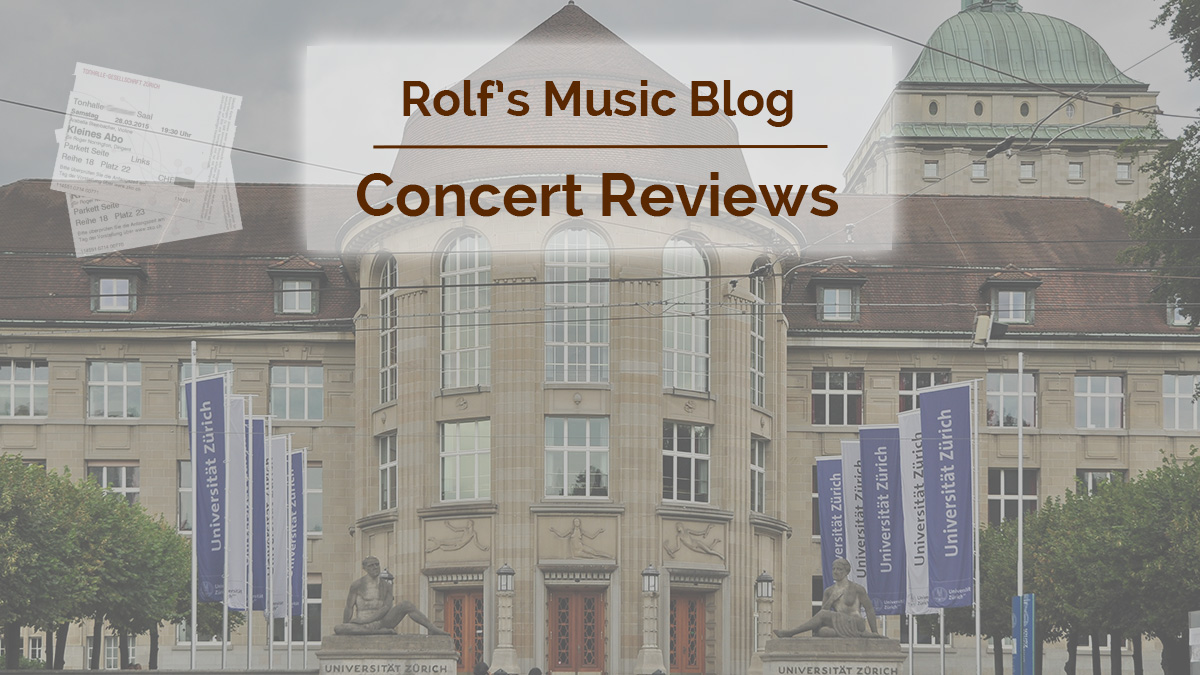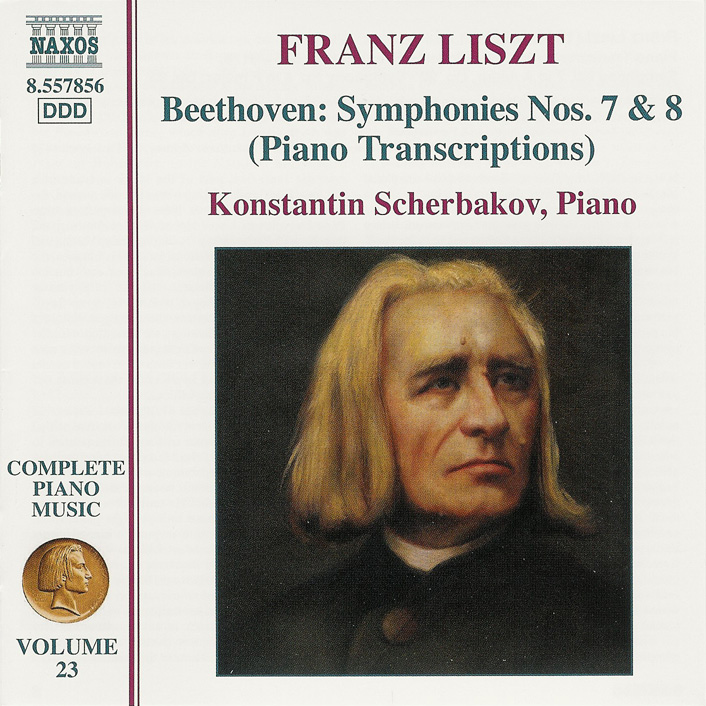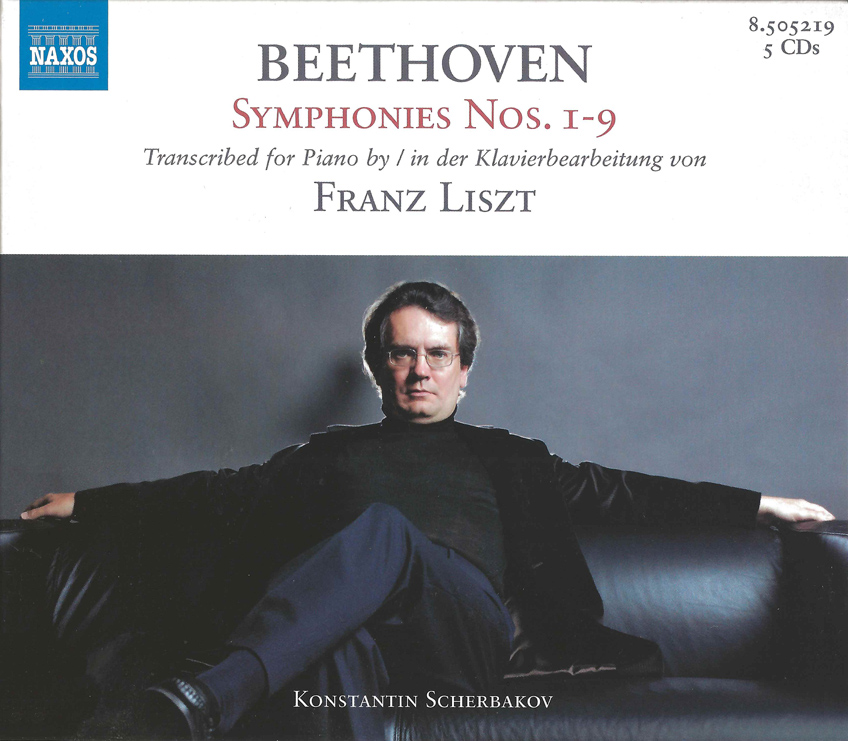Piano Recital: Konstantin Scherbakov
Debussy, Schumann, Beethoven / Liszt
Aula der Universität, Zurich, 2021-11-09
2021-11-17 — Original posting
Konstantin Scherbakov führt von Debussy über Schumann zu Liszts Transkription von Beethovens Siebter — Zusammenfassung
Der Russisch-Schweizerische Pianist Konstantin Scherbakov (*1963) gab sein erstes Rezital nach der pandemie-bedingten Supendierung des Konzertbetriebs. Er erweiterte sein aktuelles Konzertrepertoire: bisher stand Beethoven in dessen Zentrum, sowie hochvirtuose Werke vor allem von russischen Komponisten wie Godowsky, Lyapunov, Tschaikowsky. Dieses Rezital eröffnete er mit der Suite bergamasque, L.75 von Claude Debussy (1833 – 1897), gefolgt vom eher selten gespielten Faschingsschwank aus Wien, op.26 von Robert Schumann (1810 – 1856). In beiden Werken war die Aufführung—nicht überraschend—vollends überzeugend und meisterhaft.
Nach der Pause ein “heftiger Brocken”: Die Sinfonie Nr.7 in A-dur, op.72 von Ludwig van Beethoven (1770 – 1827) in der Version für Klavier zu zwei Händen (S.464/7) von Franz Liszt (1811 – 1886). Allein schon die Transkription ist ein Meisterwerk (legt vielleicht gar Schwächen in Beethovens Finale offen?). Deren Aufführung ist eine begeisternde, pianistische Parforce-Tour von 40 Minuten. Dass Konstantin Scherbakov über die dafür nötigen technischen und physischen Reserven verfügt, braucht kaum erwähnt zu werden. Zweifelsohne ein beeindruckendes Erlebnis!
Das “Sahnehäubchen” am Ende war dann die introspektive Zugabe: Beethovens Bagatelle in a-moll, op.119/9 (Vivace moderato). Stimmungsvoll, kurz, und perfekt als Abschluss!
Table of Contents
Introduction
| Venue, Date & Time | Aula der Universität, Zurich, 2021-11-09, 19:30h |
| Series / Title | Musik an ETHZ und UZH — Piano Recital Konstantin Scherbakov |
| Organizer | Musical Discovery |
| Reviews from related events | Previous piano recitals with Konstantin Scherbakov Previous recitals in the Main Convention Hall at Zurich University |
Over the past 7 years, I have witnessed the Russian-Swiss pianist Konstantin Scherbakov (*1963 in Barnaul, Siberia) in almost 10 solo recitals (see the link above). Yet, due to the pandemic, the last such encounter dates back more than 1.5 years.
As for concerts in this venue: in 2019, Musical Discovery added the Aula (Main Convention Hall) at Zurich University to its range of venues. That year, 2019, I attended three of piano recitals there. The last one of them, on 2019-05-21, was with Konstantin Scherbakov, featuring works by Beethoven exclusively.
With this, neither the artist, nor the venue need more of an introduction. I was definitely looking forward to this new encounter! I should mention the one disadvantage of performing in this venue: the instrument (owned by the University) is “just” a mid-size Steinway B-211 grand piano. It’s definitely not a bad instrument, but one that hardly can compete with Konstantin Scherbakov’s favorite “tool”, the Steinway D-274.
Program
- Claude Debussy (1833 – 1897): Suite bergamasque, L.75
- Robert Schumann (1810 – 1856): Faschingsschwank aus Wien, op.26
(Intermission) - Ludwig van Beethoven (1770 – 1827): Symphony No.7 in A major, op.72 — transcr. Franz Liszt (1811 – 1886)
Setting, etc.
The Aula (Main Convention Hall) of the University of Zurich (UZH) is bigger than the original location that the organizer, Musical Discovery, used as concert venue in the past, the venerable Semper Aula in the ETH (Federal Institute of Technology) with its 100 seats. So I did not expect this concert to be sold out. Nevertheless, I was pleasantly surprised to see that despite the pandemic, there was a very respectable audience that filled a major part of the central seating section. I took a seat in the right side lateral block, such that I could freely place my tripod and take photos. As for the photos: select any picture to view the photos in larger format.
Concert & Review
Debussy: Suite bergamasque, L.75
Claude Debussy (1833 – 1897) began composing his Suite bergamasque, L.75, in 1890. That version did undergo significant changes for the publication in 1905, though.
- Prélude: Moderato (tempo rubato)
- Menuet: Andante
- Clair de lune: Andante très expressif
- Passepied: Allegretto ma non troppo
The third movement, Clair de lune, refers to a poem with that title by Paul Verlaine (1844 – 1896). In the first stanza, that poème refers to masques et bergamasques. The latter (Bergamask, a dance in the region of Bergamo) inspired the title of the suite. Clair de lune made the Suite bergamasque one of Debussy’s most popular piano works.
The Performance
This was the first time that I witnessed Konstantin Scherbakov perform French repertoire. I did not know what to expect (almost certainly not a “Russian Debussy!”), and I definitely was curious!
No, I could not say I noted a distinctly “Russian flavor” here. What I immediately noted, though, was the outstanding clarity in Konstantin Scherbakov’s playing. I mean clarity, not dryness, of course. One may note the latter in some of the artist’s early recordings—but this certainly was not crude or bone-dry in any way.
Yes, Konstantin Scherbakov uses the sustain pedal very sparingly: it’s probably fair to say that he uses it to enhance the sonority, e.g., in a “standing chord”, or in long notes, but he does not (or very little) resort to the pedal to achieve legato. This way, he also avoids “impressionist blurring / veiling”, which I think is not adequate here. There are definitely recordings out there which use an excess of sustain pedal. Interesting: at least in the score that I have, the composer didn’t add a single (sustain) pedal mark in all of the Suite (the Clair de lune just has the general instruction con sordina which presumably is the soft pedal).
I. Prélude: Moderato (tempo rubato)
My notes from the performance state the above as general characterization. In the Prélude, I particularly enjoyed not just the clarity, but also the careful dynamic shaping of the phrasing arches. And, of course, there was the warm, full sonority, and the amazing volume that Konstantin Scherbakov achieved even from this smaller instrument. At the same time, I found the atmosphere serene, lucid, and harmonious.
There was no excess in romanticism (such as blurring through extended pedaling, etc.), though the interpretation was full of emotional warmth and intimacy. Some of it felt like a mix of recitative and intimate dialog.
II. Menuet: Andante
In the artist’s hands this was a playful piece, in accordance with the annotation pp et très délicatement. My notes again refer to lucidity and clarity. The latter was of course helped by the extended staccato segments. The melodic / legato segments not only showed diligent, careful dynamics overall (down to ppp), but also excellent dynamic balance, shaping every voice individually, allowing the listener to follow all melody layers.
III. Clair de lune: Andante très expressif
The beauty of this piece is obvious, its popularity understandable. Luckily (and expectedly), Konstantin Scherbakov did not indulge in excess rubato, blurring, romantic sweetness. Debussy’s music does not need this! The interpretation of course still was highly atmospheric and featured careful dynamic shaping and phrasing arches, up to the utterly subtle ppp ending. Distant memories, longing, melancholic, introverted, reflective—and too short!!
IV. Passepied: Allegretto ma non troppo
Another movement with aspects of playfulness—though often earnest, if not somewhat moody, capricious. The interpretation wasn’t just atmospheric—I particularly found Konstantin Scherbakov’s excellent control and use of the instrument’s sonorities admirable.
Rating: ★★★★½
Schumann: Faschingsschwank aus Wien, op.26
Robert Schumann (1810 – 1856) began composing his Faschingsschwank aus Wien, op.26, in 1839 in Vienna, then featuring four movements. He completed the work (Carnival Scenes from Vienna, or Carnival Jest from Vienna) upon his return to Leipzig, by adding one more piece. Thus, as published by Schumann’s wife, Clara Schumann (1819 – 1996), op.26 has five movements:
- Allegro: Sehr lebhaft (very lively)
- Romanze: Ziemlich langsam (Pretty slow)
- Scherzino
- Intermezzo: Mit größter Energie (With the greatest energy)
- Finale: Höchst lebhaft (Highly vivid)
Some people noted that Faschingsschwank includes the character / tone sequence ASCH-SCHA, which Schumann already referred to in his Carnaval (Carnival), op.9 from 1834 – 1835. The Wikipedia entry for the latter gives detailed background information on the topic of ASCH-SCHA. Just for clarification: ASCH translates to the notes A, Es, C, H in German terminology, or A, E♭, C, B in Anglo-Saxon terminology.
The Performance
To me, this was another first: this recital wasn’t just the first time that I heard Konstantin Scherbakov perform Debussy, but the same holds true for Schumann. Most of the past recitals focused either on Beethoven, both in the original, as well as in Liszt’s transcriptions (see below)—or then on Russian and highly virtuosic repertoire, such as works by Leopold Godowsky (1870 – 1938) or Sergei Lyapunov (1859 – 1924). Of course one should not expect the artist’s repertoire being limited to that. After all, he is a pre-eminent teacher at the ZHdK (Zürcher Hochschule der Künste).
I. Allegro: Sehr lebhaft
Ah, this beginning! The opening gesture instantly reminded me of the beginning of the Fantasie in C major, op.15, D.960 (“Wanderer Fantasy”) which Franz Schubert (1797 – 1828) wrote 1822, 17 years before Schumann began composing his op.26. Certainly in Konstantin Scherbakov’s interpretation, that linkage seemed much more evident than the alleged quote from the French national anthem, La Marseillaise. The Leitmotifs in these compositions are different in rhythm, but they share a resolute, rebelling, yet positive, uplifting spirit. OK, unlike Schumann’s opening, Schubert’s Fantasy also features a grim, desperate component…
Konstantin Scherbakov played that opening theme at a fluent tempo, with a rhapsodic “tone”, full of momentum and verve. In the subsequent song-like episode, he highlighted the cantilena in the descant, with a soft left-hand accompaniment, subtle in agogics and rubato. One can see a carnivalesque aspect in the episodic nature of this movement: the lovely, lyrical segments are barely related to the recurring main theme, nor among themselves. They all form introspective, reflecting contrasts, with the main theme as bracketing element. I particularly liked the subtle dynamics, the atmosphere in these lyrical moments.
★★★★½
II. Romanze: Ziemlich langsam
A Lied ohne Worte (song without words) in the best sense of the word! A recitative as self-reflection, dreamy, calm, solemn—yet beyond innocence. One might read sorrow, melancholy, as well as loving memories into Scherbakov’s interpretation: particularly the middle part seemed so warm, emote, intimate, touching!
★★★★½
III. Scherzino
A series of short episodes. The Scherzo character resides not just in the fragmented nature of the short piece, but also in the sudden changes in textures, dynamics, sonorities. The artist took the 16-bar ff episode in the second half (as well as the accelerating coda) distinctly faster: a Trio of sorts? Despite the fragmentation, the interpretation felt harmonious and conclusive—beyond discussions about original sound and sonorities.
★★★★½
IV. Intermezzo: Mit größter Energie
“With greatest energy”: it must be tempting to indulge in rhapsodic tone and sonorities in this piece, with its three layers of stepping left-hand octaves, the melody in the descant, and the rapidly mundulating semiquaver line in-between! Konstantin Scherbakov resisted that temptation, keeping the focus on the melody, so intense, so full of lyricism. It’s another song without words—though the artist made that melody sing beyond words!
★★★★½
V. Finale: Höchst lebhaft
Virtuosic fireworks in the main theme—and Konstantin Scherbakov truly in his element! Of course, the artist didn’t leave out an opportunity to make melodic periods (such as the second theme) sing—Schumann’s love song for Clara, no doubt! In the development part, the singing evolved into a dialog between descant and bass, momentarily intimate—until the urgence took over again, culminating in grandiose, if not jubilating gestures.
Only upon looking back, I realized how Konstantin Scherbakov consequently built up the movements towards the exhilarating Finale.
★★★★★
Overall Rating: ★★★★½
Beethoven / Liszt: Symphony No.7 in A major, op.72 / S.464/7
Ludwig van Beethoven (1770 – 1827) composed his Symphony No.7 in A major, op.92 in 1811/1812. I have posted a detailed comparison of over 10 recordings and will not add more description here. In addition, I have posted reviews from several concerts with this symphony in the original, orchestral version. Here, I’m therefore just giving the list of the movements.
- Poco sostenuto (4/4, 1/4 = 69) – Vivace (6/8, 3/8 = 104)
- Allegretto (2/4, 1/4 = 76)
- Presto (3/4, 3/4 = 132) – Assai meno presto (3/4, 3/4 = 82)
- Allegro con brio (2/4, 1/2 = 72)
Franz Liszt (1811 – 1886) finished transcribing Beethoven’s symphonies 5, 6, and 7 in 1837. Only symphonies #5 and #6 were published at that time, though. Liszt did transcribe more of Beethoven’s symphonies in the years that followed. However, it was only further developments in piano technique that ultimately made a complete set look feasible. So, Liszt “recycled” his first set of transcriptions and completed the set. He did make adjustments (few simplifications) to the original transcriptions. The full set was ultimately published 1865, dedicated to the conductor and pianist Hans von Bülow (1830 – 1894).
The Performance
For many years, Konstantin Scherbakov has Liszt’s transcriptions of the Beethoven symphonies in his repertoire, and he has also recorded the entire set, see below. 2015, I have attended two of the artist’s performances of Beethoven’s Symphony No.3 in E♭ major, op.53 (“Eroica“) in Franz Liszt’s transcription. See my reviews from the events on 2015-03-24 and on 2015-12-12 for details. What I wrote there certainly also applies to the performance in the transcription of the Symphony No.7 in A major. I understand my comments below as complement to my earlier posts.
I. Poco sostenuto –
I’m tempted to say that the first 8 bars of the symphony is somewhat ill-suited for a piano transcription. For one, the fp chords / beats sound pale on the piano (compared to the orchestra)—and I don’t think Liszt meant these to be thundering ff chords. Then, just as importantly, the piano has no chance of carry the lead motif in the oboe, clarinet, flute, and bassoon solos even remotely as well as the wind instruments, let alone build up real tension towards the ascending scales in the string. Of course, that’s not the artist’s fault!
That of course instantly changes with the ascending chord chains in bar 10ff.: from here on, Liszt’s piano transcription is nothing short of ingenious, and the listener feels “at home” almost as much as with the original!
Vivace
I really like Konstantin Scherbakov’s approach: not a dry exercise in pianistic artistry and perfection. Rather, it’s what must have been Liszt’s intent: to give access to Beethoven’s symphonies to audiences that do not have a chance to attend symphonic concerts. And, needless to say, to allow upper class audiences to enjoy Beethoven’s symphonies in a more intimate setting. In other words: Konstantin Scherbakov aimed at representing the orchestra, not Liszt’s pianistic acrobatics. If there were limitations to the artist’s performance, they mostly reflected the challenges that Liszt was facing in “condensing” a complex orchestral score into the hands of a single pianist.
Technically, I think that Beethoven’s Seventh is substantially more difficult and power-draining than the “Eroica“—not just in the full-fingered climax, and the final build-up to the towering, jubilant ending.
★★★★½
II. Allegretto
Konstantin Scherbakov took the funeral march slightly slower than Liszt’s (and Beethoven’s) Metronome marking of ♩=76 (which traditional listeners may find a tad restless). I actually found this performance more melodious than the original, the gradual crescendo to the first climax impressive and compelling.
The dolce espressivo section with the triplets in the middle voice was very touching: serene, hopeful, offering solace—better than with orchestra, indeed! Masterful also the segment starting in bar 149, where the pianist must master three diverging characters: the melody (ben marcato il canto) in the middle voice, the “marching band” in the bass, and the staccato semiquavers in the descant. This leads to a complex fugato with the funeral march theme and the staccato semiquaver line as comes building up to a ff climax in bar 214.
The climax isn’t pain and mourning as much as an intense transition to transfiguration, hope and serenity, calm. Not surprisingly, that atmosphere changes at the (almost) harsh transition from A major to A minor. Beethoven leaves a trace of hope, though, in the gentle, subtle ending. Or, at least, the ending is an open question, not just sadness and devastation.
★★★★★
III. Presto – Assai meno presto
Dancing, fast! This must have been at least at Beethoven’s metronome mark of 3/4=132. True, some of the acciaccaturas “just made it to the listener’s ear”—but definitely, the piano here is more agile than an orchestra: enthralling! The Assai meno presto (3/4=84) felt lyrical, gentle, atmospheric. In its (repeated) second part, the piano version is in far less danger of turning pompous, if not overblown (which would barely work on a concert grand).
★★★★½
IV. Allegro con brio
A huge pianistic / technical challenge, highly virtuosic. Of course, Konstantin Scherbakov made no compromise in the tempo, even accelerated from the ff in bar 22 onwards. Pianistically brilliant (both on the part of the artist, as well as on that of the transcriber).
I noted that occasionally, the pianist tended to accelerate ever so slightly. And I started wondering whether that was an indication of certain (slight) limitations in Beethoven’s finale. After all, it’s not impossible that a piano transcription reveals weaknesses in the original composition? By no means do I imply that this affected the experience in this concert: more likely, that’s just me, having listened to the symphony far too often? That’s a “hair in the soup” to be ignored—the performance was enthralling and fascinating nevertheless.
★★★★½
Overall Rating: ★★★★½
To whoever noted one or the other missing note (and two minute, negligible memory lapses): Konstantin Scherbakov performed the entire 40-minutes piece by heart—with no obvious signs of fatigue or exhaustion! A highly commendable and admirable achievement, indeed!
Encore — Beethoven: Bagatelle in A minor, op.119/9
Konstantin Scherbakov’s choice of encore made me recall a memorable concert by Hans Richter-Haaser (1912 – 1980), 50 years ago in Aarau. After an impressive recital in front of an almost empty (provincial) hall, Richter-Haaser offered 5 (!) encores. One of them he announced as “the world’s shortest pieces for piano”. This was the Bagatelle in A major, op.119/10, from the 11 Bagatellen, op.119 by Ludwig van Beethoven. Here, the artist did not select No.10, but the preceding one, Bagatelle No.9 in A minor, Vivace moderato. In an earlier recital in the same venue, on 2019-05-21, Konstantin Scherbakov had performed Beethoven’s entire op.119 as part of the recital program.
Nobody expected a virtuosic encore. Quite to the contrary. After the overwhelming experience of the Symphony No.7, a calm, reflective piece was the far better choice, and a perfect ending! Actually, can a less-than-one-minute “nothing” really persist after the preceding “monster piece”? Yes, it can—at least in Konstantin Scherbakov’s calm (if not hesitating), introverted / introspective interpretation. It was slower than most other pianists, and maybe also slower than the artist might perform it in the context of the entire op.119? In an instant, this made listeners fall into a reflective mood: appeasement and peace of mind. Thanks a lot!
Addendum: CDs Related to this Recital
Konstantin Scherbakov: Beethoven, Symphonies Nos. 7 & 8 in Franz Liszt’s piano transcription (part of the complete set shown below)
Franz Liszt: Beethoven, Symphonies Nos. 7 & 8, piano transcriptions
Konstantin Scherbakov, piano
Naxos 8.557856 (CD, stereo); ℗ / © 2006
Booklet: 8 pp. en/de
Konstantin Scherbakov: Beethoven, Symphonies Nos. 1 – 9 in Franz Liszt’s piano transcription
Franz Liszt: Beethoven, Symphonies Nos. 1 – 9, piano transcriptions
Konstantin Scherbakov, piano
Naxos 8.505219 (5 CDs, stereo); ℗ 1998 – 2006 / © 2006
Booklets with the individual CDs, typically 8 pp., en/de/fr













































